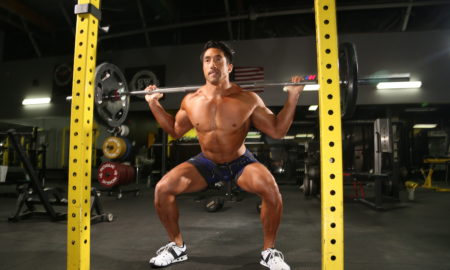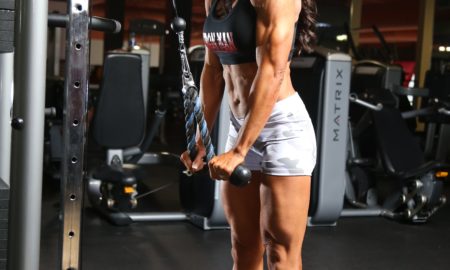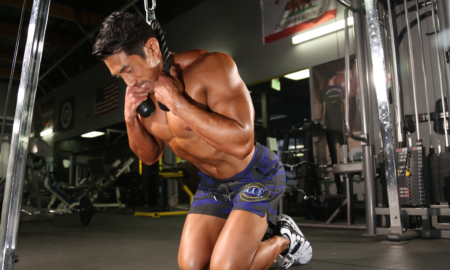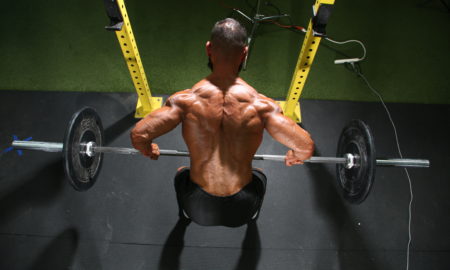 Stelios and Yiannis were experiencing the best bodybuilding progress of their lives from the simplest training they had ever done. The lesson was clear: Simple, short, hard and progressive training is the way to go. It stimulates growth and permits recuperation time between workouts. It was a far cry from how they used to train.
Stelios and Yiannis were experiencing the best bodybuilding progress of their lives from the simplest training they had ever done. The lesson was clear: Simple, short, hard and progressive training is the way to go. It stimulates growth and permits recuperation time between workouts. It was a far cry from how they used to train.
Their new routines were detailed in earlier installments of this column. In summary, Stelios’ new lower-body routine is side bends, barbell squats, leg curls, standing calf raises, partial stiff-legged deadlifts from knee height and machine back extensions. For his upper body he does machine crunches, low-incline bench presses, seated back-supported dumbbell presses, seated shrugs, pulldowns, incline dumbbell curls and hand grippers.
Yiannis’ routines are the same except that instead of barbell squats and low-incline bench presses, he substitutes parallel-grip deadlifts, using a hexagonal shrug bar, and parallel-bar dips. Instead of partial stiff-legged deadlifts, he does regular bent-legged deadlifts from the floor. Those changes reflect Yiannis’ body structure—he has longer limbs and a shorter torso than his brother does.
When I started supervising the Grimm brothers’ training, I had to correct their faulty exercise technique. Chances are that you’re making at least some of the same errors and putting yourself at risk of injury. Perhaps you’re already trying to train around injuries caused by one or more of the faults. Please identify the faults and fix them. Training without injury is essential if you’re to have a chance of realizing your bodybuilding potential.
The days when Stelios and Yiannis did jerky, explosive reps are behind them, as they should be for you too. They used to almost throw the weights up, and then almost drop them, for a rep speed of under one second up and one second down. Their rep speed is now smooth, typically two seconds for the lifting portion of each rep and another two for the lowering portion, with a second or two between reps. At the end of each work set, where effort level is at its highest, their speed slows a little, as they eke out the reps.
Many bodybuilders use too much weight in their exercises, which leads to technique corruption—even when they know what correct technique is. Use a weight that lets you barely eke out your target reps with correct technique.
Side Bends
Faults: Twisting your torso somewhat on the descent and then untwisting it on the ascent, thus combining a partial back extension with the side bend; excessive range of motion on the descent but insufficient range on the ascent; incorrect stance; performing the side bends if you have a back problem.
Fixes: Keep your torso and legs on the same plane; make all the torso movement lateral—nothing to the front or the rear; for a full, safe range of motion, descend as far as is comfortable, and then, once you return to the vertical position, continue immediately to the other side, as far as you can, then return to the vertical—all of that is a single rep; use a hip-width stance—neither so close that you risk losing your stability nor too wide. (Note: Provided you have a healthy spine, the side bend, correctly performed, will strengthen your body’s core muscles and increase their resistance to injury. If, however, your spinal musculature has problems, the side bend will probably be harmful and should be avoided.)
Barbell Squats
Faults: Squatting in soft shoes that lose form during the exercise; excessive padding on the bar where it contacts the upper back; positioning the bar too high on the traps; elevating your heels on a plate or board; having your feet too close; having your feet parallel to each other; holding the barbell with your hands too wide; leaning forward too much during the squat; ascending with your hips moving up faster than your shoulders; letting your knees move inward on the ascent; rounding your back at any time during the set; rushing between reps; not using a safety apparatus for squatting.
Fixes: Squat in shoes that provide a firm base; use little or, preferably, no padding on the bar—wear a thicker shirt if you lack trap development; keep your shoulder blades squeezed together to create a layer of tensed muscle on your upper back, and position the bar on the muscle just above the center of the top ridge of your shoulder blades. (Note: That’s lower than the bar position that most bodybuilders use, but it’s essential to avoid metal-to-spine contact and to provide a greater bar control.)
One other tip concerning squats: Most bodybuilders don’t have sufficient flexibility. Because the squat involves so much of the body’s musculature, inflexibility dramatically compromises exercise technique. You must be supple if you’re going to master squatting technique.
Next month I’ll continue with the fixes for the squat and move on to other exercises. Until then, train smart, and never forget that if you don’t sleep well or eat a first-class diet, your good work in the gym will be undermined.
—Stuart McRobert
Editor’s note: Stuart McRobert’s first byline in IRON MAN appeared in 1981. He’s the author of the new 638-page opus on bodybuilding Build Muscle, Lose Fat, Look Great, available from Home Gym Warehouse, (800) 447-0008, or www.Home-Gym.com.




















You must be logged in to post a comment Login